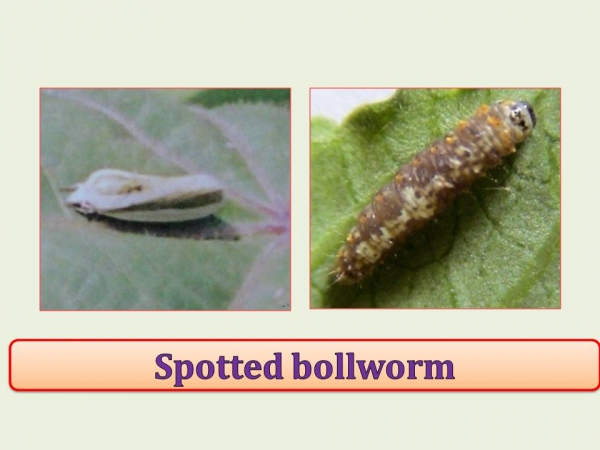
Nature of damage:
-----------------
In early stage of the crop, larva attacks the showing shoots and feed internal portion.
Shoots wither up and drop down. Later stages of the crop growth, Larva attacks the buds, flowers, squares and bolls.
Attacked buds open prematurely and shedding is the results.
While feeding, larva remains inside the bolls and entry hole is plugged with plenty of excreta.
Infested bolls open prematurely and produce poor lint, resulting in lower market value.
74-80% damage to cotton under protected conditions.
Management :
------------
Collection and destruction of damaged shoots, squares, flowers, buds and boll along with larvae.
Removal of alternate host plants from the field.
Mix cropping of okra and cotton should be avoided.
Biological control: larval parasite: Rhogas aligarensis, egg parasite: Trichogramma esculentus, Microbracon lefroyi
Spraying the crop with carbaryl 50% WP 0.20 % @ 3-4 kg/ha or phosalone 35 % EC 0.075% @ 2-2.5 lit./ha or quinalphos 25 % EC 0.05 % @ 2-2.5 lit/ha.
Following dust may be used: carbaryl 10 % dust or phosalone 4 % dust or quinalphos 1.5% dust @ 30-40 kg/ha.
After flowering, apply any one synthetic pyrethroid twice at an interval of 20-25 days. Cypermethrin 10 EC 0.009 % @ 9 ml - 50 gm ai/ha 25 EC 0.009% @ 3-4 ml 50 gm ai/ha deltamethrin 2.8 EC 0.00125 % 4-5 ml - 100 gm ai/ha fenvelrate 20%EC 0.01% @ 5 ml 100 gm ai/ha flucythrinate 10 % EC 0.007% @ 7 ml – 40 gm ai/ha fluvalinate 25% EC 0.009% @ 3-4 ml – 50 gm ai/ha alphamethrin 10% EC 0.0045% @ 4-5 ml – 25 gm ai/ha.

